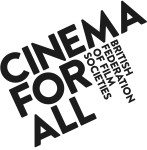FILM CLUB TRIP TO CINEMA MUSEUM & WILTON’S MUSIC HALL
16th OCTOBER 2013





Well, it was quite a day! Ronald Grant, who owns every piece of memorabilia stuffed into every corner of the Museum in Lambeth, showed us round. This was a real privilege; he has been a collector for decades (possibly since the age of four he told us!) and the collection is amazing — cinema seats, bits of carpet, art deco publicity boards, stills, magazines, teapots, mugs, old metal cinema tickets… you name it, it’s there… The original artwork in the gorgeous Chapel — a giant Charlie Chaplin, a bar made of film reels and a screen of lenses, all by Anna Odrich — were fascinating. The building has an extraordinary history and to sit where Chaplin may have sat when he visited his mother in the Workhouse was quite eerie. sb
Here’s what some of the group had to say about the trip :
The film club trip gave me a whole new perspective on cinema through the owner of the museum. Was there anything he didn’t know? I would also like to go to London again and see a show at that wonderful Wilton’s Music Hall. What a little hidden gem. Wonderful day, thoroughly enjoyed it. Rose Evison
I found the museum, and its owner, fascinating and hugely enjoyable. I could have spent all day there. Irene Williams
Eventful, quirky and memorable day. Amanda Goldsmith
Would anybody be interested in an outing to the Cinema Museum? Twelve of us thought we would be and were rewarded with “A Grand Day Out”. The outing proved to be most enjoyable, not to mention very well organised. The Museum is housed in an old workhouse. It contains a vast collection of reels and reels of film and the relevant paraphernalia including copies of most of the film magazines that have ever been published. Our tour was conducted by the very knowledgeable curator of the museum….The last treat in store for us was to gather at Wilton’s Music Hall where we enjoyed not only a glass of wine or two but also drinking in the atmosphere. Pamela Chadbourn
 Further to the trip this month, to the Cinema Museum in Lambeth near to where Charlie Chaplin was born (Walworth), David Thomson in his book, The Big Screen: The Story of the Movies and What They Did To Us, tells how Chaplin made his first stage appearance.
Further to the trip this month, to the Cinema Museum in Lambeth near to where Charlie Chaplin was born (Walworth), David Thomson in his book, The Big Screen: The Story of the Movies and What They Did To Us, tells how Chaplin made his first stage appearance.
He watched as his mother, unfortunately the worse for drink whilst performing in a music hall, fled the stage after some sailors booed her. To keep the show going the stage manager took young Charlie on to the stage to perform some song and dance routines. This was an immediate success with the audience who tossed coins onto the stage.
Charlie interrupted his performance, saying that he hoped they wouldn’t mind if he collected his money. The stage manager helped him collect it but Charlie thought he was going to keep it. Somehow, he conveyed his anxiety to the audience which further endeared him to them, especially when he followed the stage manager off stage, not returning to sing until he had given the money to his mother.
This was the first manifestation of the waif image that eventually made Chaplin the most recognisable figure in the world.

Colour, Spectacle & Transatlantic Aspirations:The Post-war Melodramas of Michael Powell & Emeric Pressburger – August 2013
KLCCC Publicity Officer, Rosemary Green, has sent in her impressions of the event we nearly didn’t have:
On a balmy evening in August I arrived early at Thoresby College to be greeted by committee club members in a bit of a panic. It appeared that we were locked out of our regular meeting room with no sign of caretaker, or key, and our talk due to start within half an hour.
 Thanks to the quick thinking of committee members present and a few phone calls, we hastily moved location to the Friend’s Meeting House. So far so good. However, on arrival it soon became clear that the room we had been so kindly offered was not going to accommodate the large numbers of people who would soon be arriving, not least because of the temperature which was still quite high, even as the sun was going down.
Thanks to the quick thinking of committee members present and a few phone calls, we hastily moved location to the Friend’s Meeting House. So far so good. However, on arrival it soon became clear that the room we had been so kindly offered was not going to accommodate the large numbers of people who would soon be arriving, not least because of the temperature which was still quite high, even as the sun was going down.
A club member suggested arranging the presentation outside in the courtyard, which had all the space we needed and was considerably cooler than the interior of the building. This was a call to action and in no time at all chairs were re-arranged (above), screens set up and cables laid down and we were ready to start. After introductions by Sue Burge we were treated to an excellent and informative talk on Powell and Pressburger given by Trish Shiel (below) who is the Film Education officer for the Cambridgeshire film Consortium.
 We learned that as the Second World War started, Alexander Korda offered Denham studios to the Ministry of Information. Although cinemas were closed in the first few months of the war in what was later referred to as ‘the phoney war’ the potential for propaganda was not lost on those men at the Ministry and after a few months cinemas were re-opened and a series of make do and mend films, along with tips on rationing in the form of ‘flash’ short films were being produced.
We learned that as the Second World War started, Alexander Korda offered Denham studios to the Ministry of Information. Although cinemas were closed in the first few months of the war in what was later referred to as ‘the phoney war’ the potential for propaganda was not lost on those men at the Ministry and after a few months cinemas were re-opened and a series of make do and mend films, along with tips on rationing in the form of ‘flash’ short films were being produced.
The rise of women as consumers was a significant factor. Female earnings increased and 1941 saw a shift in emphasis as attempts were made to attract female audiences. The 1945 film I Know Where I’m Going stars Wendy Hiller as a young middle class Englishwoman with an ambitious, independent spirit. She travels from her home in Manchester to marry wealthy, much older industrialist, on the (fictitious) island of Kiloran. When bad weather postpones the final leg of her journey—she is forced to wait it out on the Isle of Mull. There she meets a naval officer. They are sheltered for the night and the next day, as the bad weather worsens into a full-scale gale, the naval officer takes advantage of the delay to woo the young woman who becomes increasingly torn between her ambition and her growing attraction to him. I won’t spoil the story if you haven’t seen it, however, we were shown some beautifully mystical shots – very atmospheric.
We were then shown an example of another type of film intended to attract women, this time a Gainsborough melodrama called The Wicked Lady. These types of films broke all the social rules of the time and were a rip-roaring success; women loved them. It was also interesting to hear that part of the Wicked Lady was filmed at Blickling Hall.
J Arthur Rank supported British film making and Powell and Pressburger were keen to make films to export to the USA. Jack Cardiff, the great cinematographer who worked for them, was the first to receive training in how to use colour in film. These techniques were put to great effect in A Matter of Life and Death, released in 1946, and notable for its innovative use of colour. The film was made in Denham studios, with the beach scenes filmed at Saunton Sands in Devon.
Black Narcissus, a successful export to the USA, won an academy award in 1947 for cinematography. Although set convincingly in the Himalayas, all the filming was apparently done at Pinewood studios. The film makes extensive use of matte and large scale landscape paintings to suggest the mountainous environment of the Himalayas, as well as some scale models for motion shots of the convent. Mountain scenes were painted on glass. In this way Powell and Pressburger were able to maintain colour control to the very end of the film. It really is an extraordinary achievement and has made me view the film in an entirely new light.
The final film we heard about was The Red Shoes (1948) and concerns a young ballerina who joins an established ballet company and becomes the lead dancer in a new ballet called The Red Shoes, itself based on the fairy tale by Hans Christian Andersen. The film stars Moira Shearer and is well regarded for its creative use of Technicolor. We learned that film makers such as Brian De Palma and Martin Scorsese have named it one of their all-time favourite films.
As our talk drew to a close, and the sun set over the rooftops, we heard some interesting accounts from members of the audience and how some of them were fortunate, as children, to see Powell and Pressburger in action filming on location in the local area. All in all, an entertaining and informative talk, in a lovely outdoor setting; I am looking forward to the next one. rg




